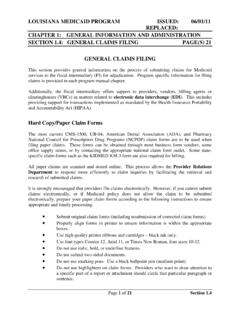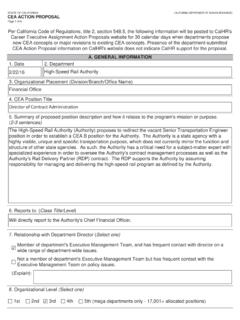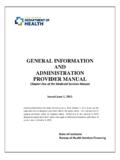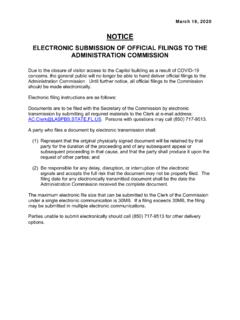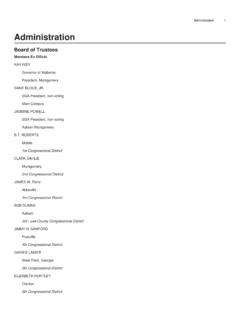Transcription of Administration General Information - University of Hawaii ...
1 254 School of Medicine 2016-2017 AdministrationJohn A. Burns School of Medicine651 Ilalo StreetHonolulu, HI 96813 Tel: (808) 692-0899/0881 Fax: (808) 692-1247 Web: : Jerris R. Hedges, MD, MS, MMMD irector of Admissions: Ivy Nip Asano, MDAssociate Dean of Clinical Affairs: Roy Magnusson, MD, MSInterim Associate Dean of Medical Education: Patricia Blanch-ette, MD, MPHD irector of Undergraduate Medical Education, MD Programs, W. F. Haning, III, MDContentsGeneral InformationThe John A. Burns School of Medicine (JABSOM) strives to improve the quality, effectiveness, and equity of health care delivery in Hawai i and the Pacific region. The school provides opportunity for qualified residents of Hawai i and the Pacific Islands, including students from various underrepresented so-cioeconomic and minority groups to qualify for an MD degree; provides MD graduates with competency to enter postgradu-ate programs; and provides residency training programs with emphasis on primary-care school also administers graduate research and profes-sional programs that lead to MS and PhD degrees in the basics medical sciences and health-related fields; BA, MS, MPH, and DrPH degrees in Public Health; MS degree in Communica-tions Sciences and Disorders; and, BS and a post-baccalaureate certificate in medical technology.
2 Medical school faculty par-ticipate in undergraduate courses for majors in nursing, dental hygiene, biology, nutrition, and related fields. In addition, the medical school, in partnership with the Hawai i Medical As-sociation and the Hawai i Consortium for Continuing Medical Education, sponsors continuing medical education for physi-cians in the state of Hawai school provides instruction for five major categories of students:1. Candidates for the MD degree who are admitted directly by the school s own admissions committee;2. Candidates for MS degrees in biomedical sciences (with con-centrations in cell and molecular biology, clinical research, physiology, and tropical medicine), public health, or in com-munication sciences and disorders apply through both the JABSOM admissions committee and the Graduate Educa-tion of UH M noa;3. Candidates for the MPH or DrPH degree who apply through Graduate Education of UH M noa; 4. Candidates for PhD degrees in biomedical sciences with con-centrations in clinical research, cell and molecular biology, epidemiology, physiology, and tropical medicine who apply through Graduate Education of UH M noa; and5.
3 Candidates for undergraduate degrees in medical technol-ogy and public health, who apply through the UH M noa Admissions Candidates for the Doctor of Medicine Early Acceptance Program are admitted by JABSOM s admissions addition, a post-baccalaureate certificate for medical technology clinical training is Program ..255 Honors and Awards ..256 Graduate Medical Education Programs ..256 Undergraduate Programs ..257 Special Programs ..257 The Doctor of Medicine Early Acceptance Program ..257 Hawai i/Pacific Basin Area Health Education Center ..257 Overseas Programs ..257 Anatomy, Biochemistry, and Physiology ..257 Cell and Molecular Sciences and Disorders ..259 Complementary and Alternative Medicine ..260 Family Medicine and Community Health ..261 Geriatric Technology .. Hawaiian Health ..265 Imi Ho la Post-Baccalaureate Program ..265 Native Hawaiian Center of Excellence ..265 Obstetrics, Gynecology, and Women s Health ..266 Pathology ..266 Pediatrics .. Health Sciences.
4 268 Surgery ..272 Tropical Medicine, Medical Microbiology, and Pharmacology ..2732016-2017 School of Medicine 255 The Kaka ako Waterfront ComplexIn 2005, the John A. Burns School of Medicine relocated to a new acre site in Kaka ako, on the water s edge, between Waik k and downtown Honolulu. The school s previous location, the 43-year-old Biomedical Sciences building on the M noa campus, continues to be occupied by the Office of Pub-lic Health Sciences, Department of Medical Technology, and by various research units. The school complex functions as an economic engine for the state that will create quality employ-ment opportunities, increase biomedical research activity, and be a stimulus for the biotechnical industry in Hawai i. Target areas of research, which include innovations in problem-based learning medical education, are retrovirology/infectious diseases/AIDS, molecular biology/genetics/neurosci-ence, genomic medicine, proteomics, and bioinformatics/com-putational campus includes an incubator center (leasable research space) to provide biotechnology and bioscience companies a campus-like environment enabling collaboration with academic researchers.
5 A major medical research center, with surround-ing space for such companies, as well as Honolulu s technology infrastructure and ties to Asia and the Pacific, will make the city of Honolulu a prime environment for the growing technology and biomedical research school is accredited by the Liaison Committee for Medi-cal Education (LCME) of the Association of American Medi-cal Colleges and the Residency and Fellowship Programs are accredited by the Accreditation Council on Graduate Medical Education (ACGME).Additionally, all civilian postgraduate medical education programs in Hawai i hospitals are accredited as UH John A. Burns School of Medicine-sponsored residency programs by the ACGME. Approximately 250 physicians (employees of Hawai i Residency Programs, Inc.) within 14 training programs serve as house staff members in these hospitals under the direc-tion of medical school faculty from eight clinical departments. Oversight is provided by the Designated Institutional Official (DIO).
6 Continuing Medical Education (CME) programs are accredited by the Hawai i Consortium for Continuing Medical Education (HCCME), a liaison committee between the Hawai i Medical Association and JABSOM, while the public health degrees are accredited by the Council on Education for Public Health (CEPH), Medical Technology (MEDT) and Commu-nication Sciences and Disorders (CSD) are accredited by Na-tional Accrediting Agency for Clinical Laboratory Sciences and American Speech-Language-Hearing Association school maintains affiliations with facilities for medical student and resident clinical training that include the following: Castle Medical Center, Hawai i State Hospital, Hilo Medical Center, Kalihi-Palama Health Center, Kaiser Permenente Mo-analua Medical Center & Clinic, Kapiolani Medical Center for Women and Children, Kapiolani Medical Center at Pali Momi, Kokua Kalihi Valley Health Center, Kuakini Health Systems, Leahi Hospital, Maui Memorial Medical Center, The Queen s Medical Center, Queen Emma Clinics, Rehabilitation Hospital of the Pacific, Shriners Hospital for Children, Spark Matsunaga VA Medical Center, Straub Clinic and Hospital, Tripler Army Medical Center, Wahiawa General Hospital, and The Physician Center.
7 DegreesBachelor s Degrees: BS in medical technology, BA in public healthMaster s Degrees: MS in biomedical sciences (cell and molecular biology, clinical research, physiology, and tropical medicine); MPH and MS in public health; MS in communication sciences and disordersProfessional Degree: MDDoctoral Degrees: PhD in biomedical sciences (cell and mo-lecular biology, clinical research, and tropical medicine); PhD in developmental and reproductive biology; PhD in epidemiol-ogy; DrPH in public healthAdvisingPremedical advising is available through the Pre-Health/Pre-Law Advising Center, Sinclair Library PoliciesUndergraduate and graduate students in the School of Medi-cine must adhere to the academic policies of UH M noa. Medi-cal students are exempted from certain UH M noa policies and instead must follow academic policies germane to the MD program. Copies of relevant policies are available in JABSOM s Office of Student ProgramThe MD program follows a problem-based curriculum, the MD Program, which was implemented in fall 1989 and includes the following key features: knowledge is acquired in problem-based modules; self-directed learning is fostered in small group tutorials; students are involved actively in the learn-ing process, not simply passive recipients of Information ; the small group leaders function as facilitators of learning; content experts function as resources to the learning process; laboratory exercises, demonstrations, the library and audiovisual-computer centers supplement faculty input; basic sciences are learned pri-marily in the context of solving clinical problems; students are trained to think critically and to evaluate new Information and research data.
8 And evaluation of students is based on compe-tence in a variety of problem-solving learning activities in the first two years of the curricu-lum take place in the school s state-of-the-art Medical Educa-tion Building and in community health sites. The advanced clinical instruction that constitutes the bulk of the second two years of instruction takes place in affiliated community hospi-tals and Requirements/Application ProcessCandidates for MD training must complete a minimum of 90 college-level semester credit hours of which the following specific science coursework is required for entry into the MD curriculum. 8 semester credit hours of biology with lab 8 semester credit hours of General physics with lab 8 semester credit hours of General chemistry with lab 8 semester credit hours of organic chemistry with lab 3 semester credit hours of biochemistry (no lab required) 3 semester credit hours of cell and molecular biology (no lab required)Each course should be acceptable for students majoring in the above science disciplines.
9 Additional enrichment in the 256 School of Medicine 2016-2017biological and social sciences is encouraged. Applicants must also be fully competent in reading, speaking, and writing the English are required to apply through the American Medical Colleges Application Service (AMCAS). The service permits an applicant to file a single web-based application, which is forwarded to participating medical schools as desig-nated on the AMCAS application. AMCAS will implement a criminal background check on applicants applying to medical schools. The AMCAS application is available from June 1 at the AMCAS website: The deadline to transmit the application to AMCAS is November 1 for regular admis-sion (EST) or August 1 (EST) for Early Decision and Doctor of Medicine Early Acceptance Program must also take the nationally administered Medical College Admissions Test (MCAT), which deals with knowledge of the biological and biochemical foundations of living systems; chemical and physical foundations of biological systems; psychological, social, and biological foundations of behavior; and critical analysis and reasoning skills.
10 The Medical College Admissions Test (MCAT) must be taken within three years of an applicant s anticipated matriculation to medi-cal school. The latest MCATs screened or re-screened in the admissions process is September of the year of application (May for Early Decision) and Doctor of Medicine Early Acceptance Program Students. Applicants who achieve the required screening cut-off points will be requested to submit additional materials and invited for interviews. Seventy MD candidates are accepted to the entering first-year regarding admissions should be directed to the Office of Admissions, John A. Burns School of Medicine, 651 Ilalo Street, MEB 3rd floor, Honolulu, HI 96813 or via email Further Information may be obtained on the web at Honors and AwardsAlpha Omega Alpha is the honorary society for medical students. Delta Omega is the honorary society for public health Medical Education ProgramsGraduate medical education programs in Hawai i hospitals are in family medicine, sports medicine, internal medicine, geriatric medicine, obstetrics and gynecology, orthopaedic surgery, pathology, pediatrics, neonatal-perinatal medicine, developmental-behavioral pediatrics, psychiatry (adult, child and adolescent, geriatric, addiction), General surgery, surgical critical care, cardiology, and transitional year.

